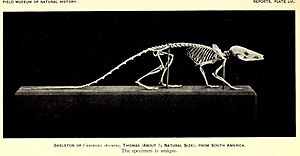Northern caenolestid facts for kids
Quick facts for kids Northern caenolestid |
|
|---|---|
 |
|
| Skeleton, Field Museum | |
| Conservation status | |
| Scientific classification | |
| Genus: |
Caenolestes
|
| Species: |
convelatus
|
| Subspecies | |
|
|
 |
|
| Range of the northern caenolestid | |
The northern caenolestid (Caenolestes convelatus) is a small, furry animal. It is also called the blackish shrew opossum. This animal lives in the countries of Colombia and Ecuador. It is a type of shrew opossum, which are small marsupials. The IUCN (International Union for Conservation of Nature) says it is a Vulnerable animal. This means it needs protection because its numbers are decreasing.
Contents
About the Northern Caenolestid
What is a Shrew Opossum?
The northern caenolestid belongs to a group of animals called shrew opossums. These animals are part of the family Caenolestidae. They are not true shrews or opossums, but they look a bit like them. They are small mammals that live in South America.
How Scientists Classify Them
The northern caenolestid is one of five types of animals in the Caenolestes group. An American zoologist named Harold Elmer Anthony first described this animal in 1924. For a while, scientists thought Caenolestes was closely related to another group called Lestoros. But later, they found that Lestoros looks different.
A study in 2013 looked at how these animals are related. It checked their body shapes and their mitochondrial DNA. This study showed that the Incan caenolestid and the long-nosed caenolestid are closely related to each other. They are like a "sister group" to the Caenolestes group.
Here is a diagram showing how these animals are related:
|
|||||||||||||||||||||||||||||||||||||||||||||||||
Different Types of Northern Caenolestids
There are two main types, or subspecies, of the northern caenolestid:
- C. c. barbarensis: This type lives in western Colombia. It was described by H. E. Anthony in 1924.
- C. c. convelatus: This type lives in northwestern Ecuador. It was described by Bublitz in 1987.
What Its Name Means
The name Caenolestes comes from ancient Greek words. "Kainos" means "new," and "lestes" means "robber" or "pirate." So, its name means something like "new robber." Fossils of caenolestids show they have been around for a very long time. They date back to the early Eocene period, which was nearly 55 million years ago.
What Does It Look Like?
The northern caenolestid looks a lot like the gray-bellied caenolestid. They have similar fur colors. However, they have some differences in their skulls.
Scientists have measured these animals to learn more about them. Here are some measurements from one adult male found in Colombia in 1969:
- Total length (from nose to tail tip): 222 millimeters (about 8.7 inches)
- Tail length: 114 millimeters (about 4.5 inches)
- Hindfoot length: 18 millimeters (about 0.7 inches)
- Ear length: 14 millimeters (about 0.55 inches)
- Weight: 25.0 grams (about 0.9 ounces)
Where It Lives and Its Home
The northern caenolestid lives in high mountain areas. It can be found in alpine forests and secondary forests. These are forests that have grown back after being cut down.
The populations of this animal seem to be in two main areas. One group lives in the Andes mountains of western Colombia. The other group lives in north-central Ecuador. In Colombia, they live at heights from about 1,800 to 3,800 meters (about 5,900 to 12,500 feet). In Ecuador, they have been seen even higher, at about 4,100 meters (about 13,500 feet).
Why It Is Vulnerable
In 2008, the IUCN listed the northern caenolestid as "Vulnerable." This is because it is only found in a small area. This area is about 20,000 square kilometers (about 7,700 square miles). A big problem for these animals is deforestation. This means forests are being cut down. This problem is even worse in Ecuador. Losing their forest homes makes it harder for these animals to survive.
See also
 In Spanish: Caenolestes convelatus para niños
In Spanish: Caenolestes convelatus para niños


